| |
HAWKS & EAGLES Accipitridae |
- 247 species worldwide
- DR personal total: 194 species (78%), 122 photo'd
|
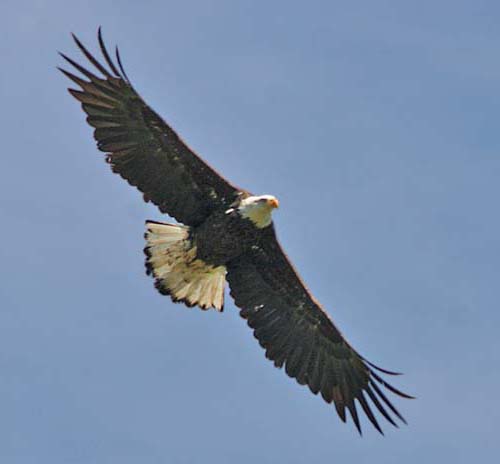 The
Accipitridae — the family of hawks, eagles, kites, harriers, and Old
World vultures — includes some of the world's most awe-inspiring birds.
The sizes of birds-of-prey range from the tiny Pearl Kite Gampsonyx swainsonii
of South America, at a maximum of 100 grams, to the largest Old World
vultures at up to 12.5 kg, some 12-and-half times larger (Thiollay
1994). There are large and impressive eagles on every wooded continent.
Two examples are African Hawk-Eagle of sub-Saharan Africa (above) and Bald Eagle
of North America (left). Among the most spectacular are those great
tropical eagles that subsist on arboreal mammals. In Africa,
Verraeaux's Eagle Aquila verreauxii makes a specialized living on hyraxes. The BBC series "The Life of Birds with David Attenborough" has incredible shots of Martial Eagles hunting monkeys. In the Neotropics there is Harpy Eagle
(below left); we'd unintentionally flushed this adult from its prey (a
forest deer) not far from a known nest. And in the Philippines, the
greatest of all eagles — the Great Philippine Eagle,
once called the "Monkey-eating Eagle" (below right in an outstanding
shot by Ian Merrill) — hunts the treetops for civets, colugos, flying
squirrels, and monitor lizards. The
Accipitridae — the family of hawks, eagles, kites, harriers, and Old
World vultures — includes some of the world's most awe-inspiring birds.
The sizes of birds-of-prey range from the tiny Pearl Kite Gampsonyx swainsonii
of South America, at a maximum of 100 grams, to the largest Old World
vultures at up to 12.5 kg, some 12-and-half times larger (Thiollay
1994). There are large and impressive eagles on every wooded continent.
Two examples are African Hawk-Eagle of sub-Saharan Africa (above) and Bald Eagle
of North America (left). Among the most spectacular are those great
tropical eagles that subsist on arboreal mammals. In Africa,
Verraeaux's Eagle Aquila verreauxii makes a specialized living on hyraxes. The BBC series "The Life of Birds with David Attenborough" has incredible shots of Martial Eagles hunting monkeys. In the Neotropics there is Harpy Eagle
(below left); we'd unintentionally flushed this adult from its prey (a
forest deer) not far from a known nest. And in the Philippines, the
greatest of all eagles — the Great Philippine Eagle,
once called the "Monkey-eating Eagle" (below right in an outstanding
shot by Ian Merrill) — hunts the treetops for civets, colugos, flying
squirrels, and monitor lizards.
|
|
For decades I've judged the Great Philippine Eagle
as the world's "best bird" (see my photo collage below that combines an
in-the-field flight shot superimposed on the forest background taken at
the same location). The world's "best bird" is now critically
endangered in its remote Philippine forested refuge.
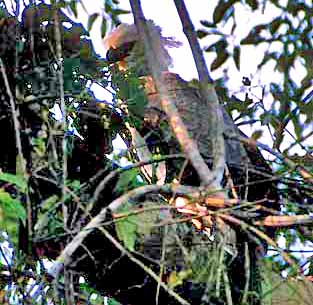 I've
had the good fortune to have quality experiences with both a nesting
Harpy Eagle and a nesting Philippine Eagle. The story of seeing the
latter at its nest in the wild in February 1990, with more photos, was posted on-line years
ago. When I returned to the location — Mt. Katanglad on Mindanao — 15
years later, much of the lower montane forests were gone. And although
a pair was nesting that year, I did not see it at all, although some
members of our tour group did have a spectacular momentary fly-by. I've
had the good fortune to have quality experiences with both a nesting
Harpy Eagle and a nesting Philippine Eagle. The story of seeing the
latter at its nest in the wild in February 1990, with more photos, was posted on-line years
ago. When I returned to the location — Mt. Katanglad on Mindanao — 15
years later, much of the lower montane forests were gone. And although
a pair was nesting that year, I did not see it at all, although some
members of our tour group did have a spectacular momentary fly-by.
These experiences did not often come easily. It
took me seven trips over 24 years into Harpy Eagle habitat to observe
one. Once, in eastern Ecuador, Rita & I were on a trail deep in the
forest with local guide, Fausto. As we struggled unsuccessful to see a
monklet heard by the guide, Fausto wandered down the trail and was
shocked by a Harpy Eagle gliding into the canopy, snatching a monkey
and flying off. Rita & I missed it just by moments and a few yards.
It was not until a decade later that we rushed together a trip to a
known nest in Brazil. Even then, when we got to the nest, it was empty.
You can image the distress of our local guide on that occasion!
Fortunately, Rita spotted the recently-fledged young Harpy Eagle in a nearby tree (right).
|
|
| Such large eagles take years to reach maturity. In the tropical African savanna, Martial Eagle
shows a very pale to white juvenal plumage (below left) but becomes
entirely dark-headed as an adult (below right). Likewise, along
Africa's rivers and lakeshore, a juvenile African Fish-Eagle (second row, left) looks quite different than the familiar adults (second row, right). |
|
|
|
Another impressive eagle is Chaco Eagle of open woodland in central South America (above). It is now placed in genus Buteogallus, as is Solitary Eagle B. solitarius and Savanna Hawk B. meridionalis, and such well-known Buteogallus species as Common Black Hawk B. anthracinus and Great Black Hawk B. urubitinga. I often think of these latter Buteogallus
hawks as specialists in feeding along streams or estuary edges, eating
amphibians (especially frogs), crabs and freshwater crayfish.
Meanwhile, down under in the southern hemisphere in Australia, the largest predator bird is Wedge-tailed Eagle (below left), with the moon setting behind it. It is widespread throughout the interior of Australia
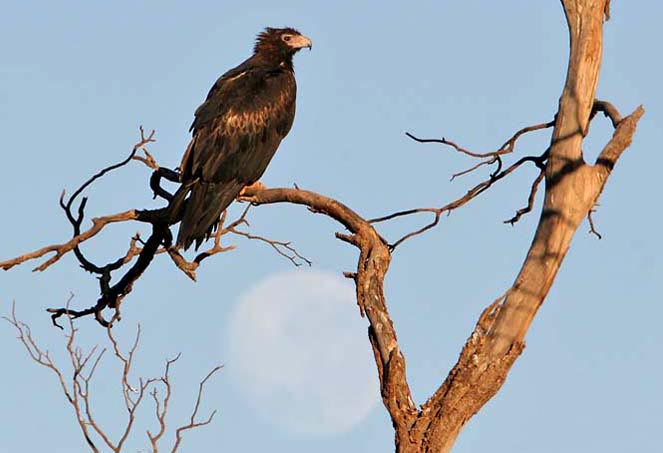 There are huge eagles at high latitudes also. In far northeastern Asia, a large female Steller's Sea-Eagle
may be the world's heaviest eagle. These impressive giants winter south
to Japan. Our only encounter, though, was this vagrant in North
America: an adult that spent a couple of years near Juneau, Alaska. To
see it one had to charter a helicopter to fly over the glaciers in the
mountains behind town, and follow the Taku River, trying to spot it as
it sat atop a riverside conifer (below). There are huge eagles at high latitudes also. In far northeastern Asia, a large female Steller's Sea-Eagle
may be the world's heaviest eagle. These impressive giants winter south
to Japan. Our only encounter, though, was this vagrant in North
America: an adult that spent a couple of years near Juneau, Alaska. To
see it one had to charter a helicopter to fly over the glaciers in the
mountains behind town, and follow the Taku River, trying to spot it as
it sat atop a riverside conifer (below).

|
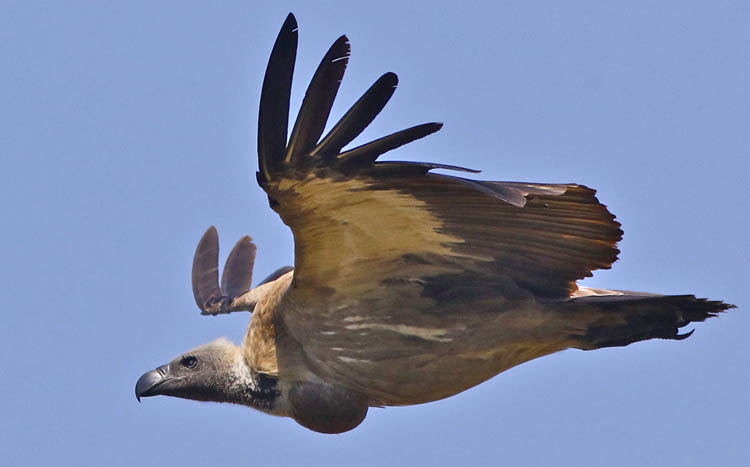 Another
impressive group is the Old World Vultures [New World vultures are only
distantly related to hawks, and are placed in their own Family.] Times
are changing for many Old World vultures. Several, such as White-backed Vulture
(right) and of sub-Saharan Africa (right), have joined the list of
critically endangered vultures that began with the large vultures of
India since 2000. The White-rumped Vulture of south
Asia (there are more than 50 gathered at the carcass shown below) was
estimated at several million in the 1980s. As of 2016, the global
population was estimated at less than 10,000 adults. These and other
Asian vultures have crashed due to renal failure caused by diclofenac
poisoning. Until banned recently, diclofenac was used in veterinary
care of the abundant cattle in south Asia. It wiped out 99% of the
world's population of White-rumped Vulture, Slender-billed Vulture Gyps tenuirostris, and Indian Vulture G. indicus,
as well as many Red-headed Vulture Sarcogyps calvus. In recent years,
the use of diclofenac, as well as the use of strychnine and other
poisons, in Africa has led to very serious declines in White-backed
Vulture, Rüppell's Vulture Gyps rueppelli, and
Lappet-faced Vulture. In Africa, cattle grazing has taken over much
formerly wild land in which African vultures would consume the
carcasses of kills from lions, leopards, and hyenas.The three photos
below illustrate vulture abundance in earlier times. One cannot now see
a gathering White-rumped Vultures in India as show in my 1978 shot: Another
impressive group is the Old World Vultures [New World vultures are only
distantly related to hawks, and are placed in their own Family.] Times
are changing for many Old World vultures. Several, such as White-backed Vulture
(right) and of sub-Saharan Africa (right), have joined the list of
critically endangered vultures that began with the large vultures of
India since 2000. The White-rumped Vulture of south
Asia (there are more than 50 gathered at the carcass shown below) was
estimated at several million in the 1980s. As of 2016, the global
population was estimated at less than 10,000 adults. These and other
Asian vultures have crashed due to renal failure caused by diclofenac
poisoning. Until banned recently, diclofenac was used in veterinary
care of the abundant cattle in south Asia. It wiped out 99% of the
world's population of White-rumped Vulture, Slender-billed Vulture Gyps tenuirostris, and Indian Vulture G. indicus,
as well as many Red-headed Vulture Sarcogyps calvus. In recent years,
the use of diclofenac, as well as the use of strychnine and other
poisons, in Africa has led to very serious declines in White-backed
Vulture, Rüppell's Vulture Gyps rueppelli, and
Lappet-faced Vulture. In Africa, cattle grazing has taken over much
formerly wild land in which African vultures would consume the
carcasses of kills from lions, leopards, and hyenas.The three photos
below illustrate vulture abundance in earlier times. One cannot now see
a gathering White-rumped Vultures in India as show in my 1978 shot:
|
 |
central
Indian
vultures
1978:
mostly
White-
trumped |
 |
northwest
Indian vultures
2001:
mostly
Cinereous
(L) and
Red-
headed
(R)
|
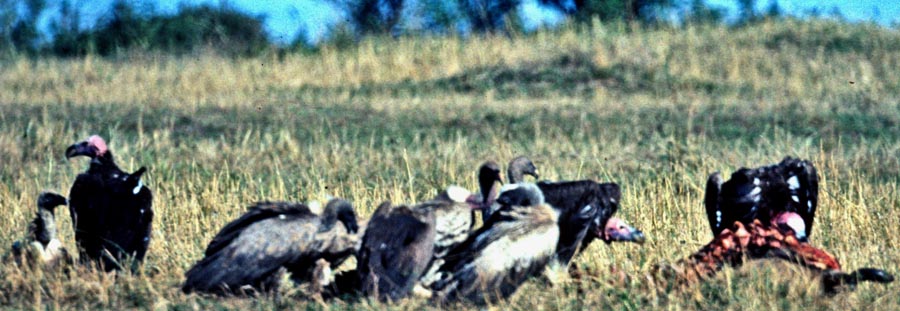 |
Kenyan
vultures
1981:
mostly
Lappet-
faced (L
& R)
and
White-
backed
|
|
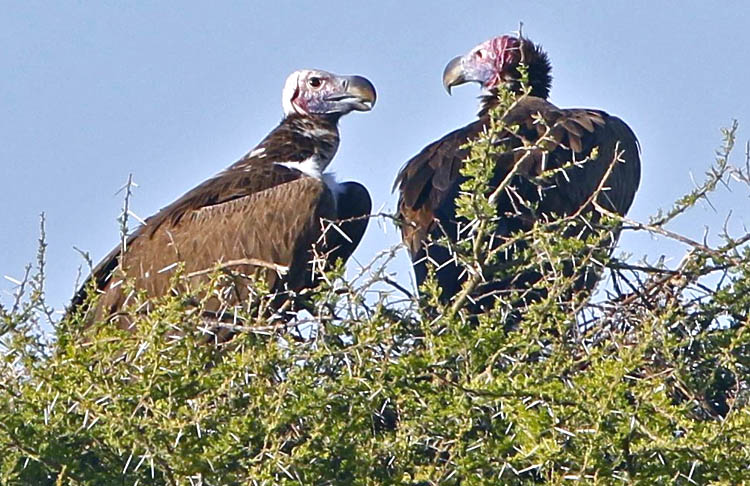 Today, congregations of African vultures are often limited to National Parks and preserves. This shot of a young Lappet-faced Vulture with its parent was at a nest in Tarangire NP, Tanzania. Today, congregations of African vultures are often limited to National Parks and preserves. This shot of a young Lappet-faced Vulture with its parent was at a nest in Tarangire NP, Tanzania.
A distinctive and spectacular Old World vulture is Bearded Vulture, often called Lammergeyer
(below in flight high over the Tibetan plateau). Bearded Vulture is a
signature icon of crags in remote mountain wilderness in Eurasia and
Africa. They even reside at at altitudes of 7500 m (24,600 ft) on Mount
Everest.
Like other vultures, Bearded Vulture is a scavenger
but regularly disdains dead meat in preference for bone marrow; it is
the only bird that specializes in feeding on marrow (Fergussen-Lees
& Christie 2001). It can swallow whole or bite through bones up to
the size of a lamb's femur and has learned to crack bones too large to
be swallowed by dropping them in flight to smash upon the rocks below.
Breeding Bearded Vultures do feed scavenged meat to their nestlings,
mostly that of wild sheep or goats, but are also known to take live
prey as large as monitor lizards (Margalida et al. 2009). Once thought
to be related the Gyps clade of Old World vultures, it is now known to be more closely related to Egyptian Vulture Neophron percnopterus. |
|
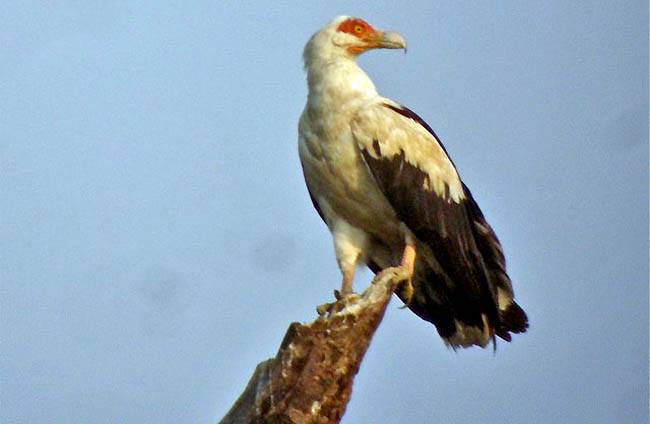
In contrast, Palm-nut Vulture (left) of sub-Saharan Africa feeds mainly on the fleshy fruit-husks of the oil-palm (Elaeis sp.) and the fruits of raphia-palm Raphia australis.
Its distribution matches the distribution of these palms, and it is
most common in coastal forests and mangrove swamps below 1500 m.,
although it does wander widely across the African savannas.
The
huge eagles and Old World vultures are certainly of interest, but the
bulk of the Accipitridae are the smaller hawks, buzzards, hawk-eagles,
serpent-eagles, harriers, kites and relatives, to which we now turn. |
 In
much of the world, and especially the temperate zones, the basic "hawk"
(often called "buzzard" in the Old World) belongs to the genus Buteo or Butastur.
Some 32 species are distributed across the largest continents,
Caribbean islands and Madagascar, and to the Galapagos and Hawaii. In
much of east Africa that species is Augur Buzzard (right). In California where I live our usual hawk — the default i.d. for any large soaring raptor — is the Red-tailed Hawk
(both photos below of the same nest). This nesting pair were raising
two chicks but had to suffer attacks from an aggressive Northern
Mockingbird disturbed by the presence. The mimid's concern seems
unwarranted as Red-tailed Hawk eats small mammals and snakes. As in
many Buteos, the Red-tail comes in a bewildering variety of plumages
and color morphs, the whole spectrum of which cannot be shown in any
literature. One learns to use shape, size and behavior. In
much of the world, and especially the temperate zones, the basic "hawk"
(often called "buzzard" in the Old World) belongs to the genus Buteo or Butastur.
Some 32 species are distributed across the largest continents,
Caribbean islands and Madagascar, and to the Galapagos and Hawaii. In
much of east Africa that species is Augur Buzzard (right). In California where I live our usual hawk — the default i.d. for any large soaring raptor — is the Red-tailed Hawk
(both photos below of the same nest). This nesting pair were raising
two chicks but had to suffer attacks from an aggressive Northern
Mockingbird disturbed by the presence. The mimid's concern seems
unwarranted as Red-tailed Hawk eats small mammals and snakes. As in
many Buteos, the Red-tail comes in a bewildering variety of plumages
and color morphs, the whole spectrum of which cannot be shown in any
literature. One learns to use shape, size and behavior. |
|
| Buteonine raptors vary from resident species to long-distance migrants. Grasshopper Buzzard
(below right) ranges across the Sahel zone of sub-Saharan Africa but
its movements are affected by prey changes in the continuum of wet-dry
seasonality. It often follows the tracks of fires, eating grasshoppers
and other insects flushed around the burning edges. The Arctic breeding
Rough-legged Hawk (below center) is a long-distance
migrants. Regular in winter in the interior of North America, during
"invasion years" immatures (like this one) may turn up hundreds of
miles farther south. Two temperate North American species —
Broad-winged Hawk from the the east and Swainson's Hawk from the west —
migrate in incredible numbers, circling in huge "kettles" on rising
thermals for long distances. A Broad-winged Hawk is diving on a Swainson's Hawk
in this photo from east Texas (below right). These two raptors are the
fundamental core of New World hawk-watching. Numerous hawk-watching
atop mountains or ridges dot North America [some great eastern U.S.
sites were outlined in Heintzelman (1976); an impressive California
site at Pt. Diablo, Marin Co., is detailed in Binford (1979)]. Migrant
Swainson's Hawks in spring and fall form the "river of hawks" at sites
from southern Mexico to Panama. Raptor migration can be just as
impressive in the Old World, at places like Falsterbo, Sweden; the
Bosporus, Turkey; and Eilat, Israel. There is even an important
migration of Black Baza Aviceda leuphotes in southeast Asia. |
|
 There are 16 species of harriers in genus Circus scattered throughout the world. Most hunt small mammals by quartering over marshes and wetlands on tilt-up wings. Spotted Harrier (right) of Australia can survive in the vast arid desert in the interior of the continent. There are 16 species of harriers in genus Circus scattered throughout the world. Most hunt small mammals by quartering over marshes and wetlands on tilt-up wings. Spotted Harrier (right) of Australia can survive in the vast arid desert in the interior of the continent.
Some of the harriers show distinctive sexual dimorphism. The adult male Northern Harrier
of North American is gray above and white below (below) while the
females are mostly mottled brown and young harriers are buffy-orange
below.
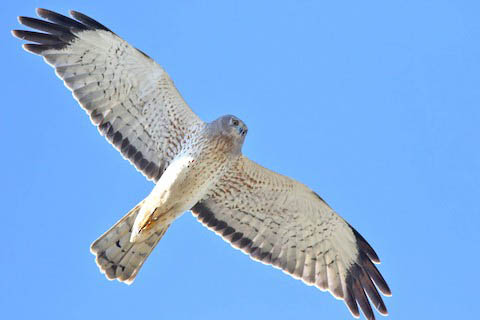
Many
of the Owl World harriers are long-distance migrants from northern
Eurasia to Africa or the Middle East, but there are also island
residents such as Reunion Harrier C. mailliardi, found only on that island in the Indian Ocean. |
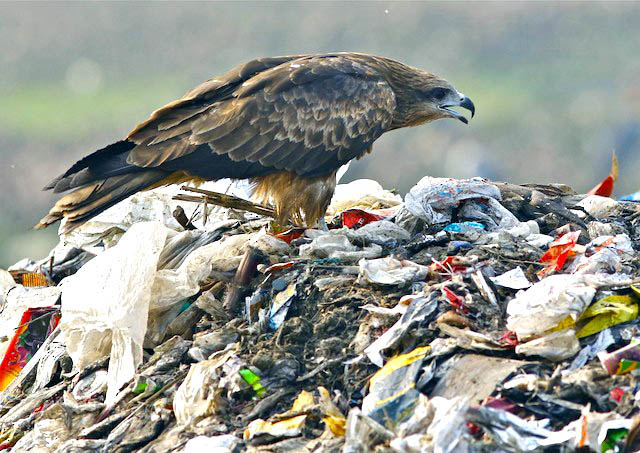 There
are almost 30 raptors in 18 genera that are called "kites." This is not
a natural groups but, rather, an assortment of mid-sized hawks, some of
which excel at 'kiting" — effortlessly soaring and gliding in thermals
in search of food —or gracefully "hanging in the air" by hovering.
Black Kites (Milvus migrans) and is widespread across
Eurasia and Africa, various considered either three species (Black
Kite, Yellow-billed Kite, Black-eared Kite) or one polymorphic and
variable species. Some populations are resident and otherwise
migratory. Many populations live commensally with humans, becoming a
very familiar species and heir angled wing and forked tail makes them
easy to identify. Global population estimates run up to 6 million
individuals. Unlike other kites, Black Kites are opportunistic hunters
and are more likely to scavenge. This "Black-eared" Blake Kite (left) is scavenging in a huge rubbish dump in eastern India. There
are almost 30 raptors in 18 genera that are called "kites." This is not
a natural groups but, rather, an assortment of mid-sized hawks, some of
which excel at 'kiting" — effortlessly soaring and gliding in thermals
in search of food —or gracefully "hanging in the air" by hovering.
Black Kites (Milvus migrans) and is widespread across
Eurasia and Africa, various considered either three species (Black
Kite, Yellow-billed Kite, Black-eared Kite) or one polymorphic and
variable species. Some populations are resident and otherwise
migratory. Many populations live commensally with humans, becoming a
very familiar species and heir angled wing and forked tail makes them
easy to identify. Global population estimates run up to 6 million
individuals. Unlike other kites, Black Kites are opportunistic hunters
and are more likely to scavenge. This "Black-eared" Blake Kite (left) is scavenging in a huge rubbish dump in eastern India.
|
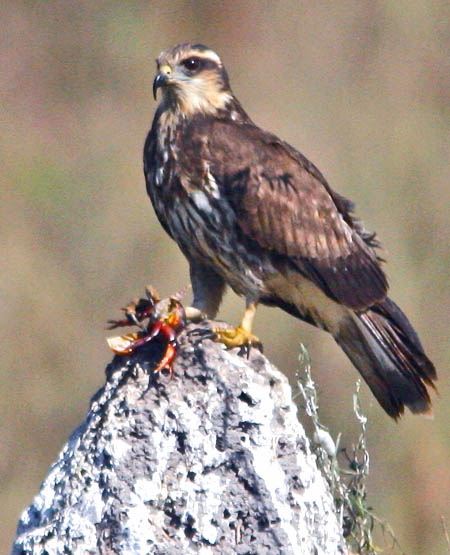 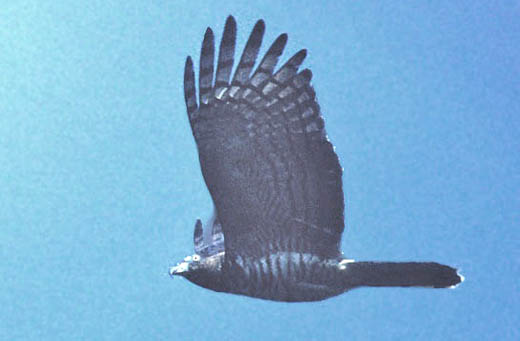
A variety of Neotropical kites take a variety of wild prey. Hook-billed Kite
(female in flight, above) is widely distributed in South and Central
America, north to the Rio Grande River in south Texas. It is unusual in
its variation in bill size, which does not vary geographically but is
bi modally distributed in many parts of the range. There are
large-billed and small-billed individuals — large bills twice as big as
small ones — in both sexes and all ages. This bill dimorphism is an
evolutionary solution to their main food source, tree snails. The
variation in bill sizes allows the Hook-billed Kite to feed on
different species and sizes classes of snails (Schulenberg 2018). Snail Kite (an
immature individual at right) is another specialist. In its Everglades
range in Florida its dietary preferences run primarily to the apple
snail Pomacea but, like Hook-billed Kite, its wide range goes
to the Brazilian Pantanal, where this youngster was eating a freshwater
crustacean.
The four kites in genus Elanus
are gray-and-white raptors on open country distributed across all the
major continents. There are distinctive black patches on the wings of
each species. They quarter low over grasslands in search of small
rodents, and are beautiful in flight. Examples include White-tailed Kite of North America (below left) and Letter-winged Kite of the arid outback of Australia (below right). |
|
|
There are a huge number of bird-eating hawks in the world, most of them in the genus Accipiter,
with 45 species comprising about 18% of the family. Many species are
rare or local; many are difficult to identify. In North America there
are two widespread species, difficult to separate without practice. The
one shown (above) is Cooper's Hawk (a very lucky shot
of a preening juvenile). Many Accipiters fly through the forest in
search of small avian prey; some even frequent bird-feeders.
Identification of Accipiters can be difficult. In the past I found good
starting points in Dunne, Sibley & Sutton (1988) and Kaufman
(1990); see also Clark & Wheeler (1987) and Wheeler & Clark
(1995) for North America; Porter et al. (1981) and Forman (1999) for
Europe and the Middle East; and specialized articles such as Morris
& Hawkins (1998) on Madagascar Accipiters. In the 20
years since I listed these references in the first version of this web
page, the literature on raptor identification has become extensive and
much more thorough. |
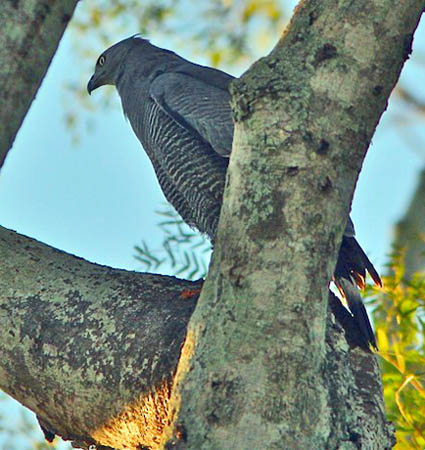 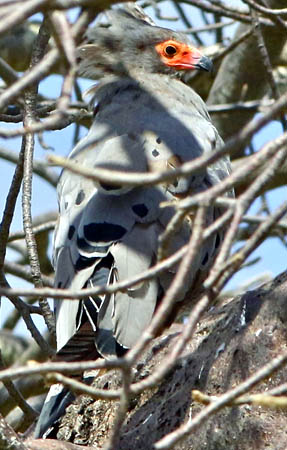 A
set of very opportunistic hawks are the harrier-hawks of Africa and
Madagascar (two species; sometimes called Gymnogenes) and the Crane
Hawk of the Neotropics. Both the African Harrier-Hawk (near right) and the Crane Hawk
(far right) are mid-sized, lanky, long-legged raptors of open forests
that sport a short crest. The Harrier-Hawk is also bare-faced. Over the
years various authors have noted similarities in morphology and feeding
habitats between these widely separated species. Both prey upon small
mammals, frogs, lizards, bird nests, and insects, which are found by
climbing around on tree trunks and limbs, peering into crevices and
holes while hanging at odd angles. The Harrier-Hawk even has a
reversible intertarsal ("knee") joint which can bend backward, as well
as forward, enabling the bird to reach into deep holes to extract the
contents. For prey that would otherwise be inaccessible, they may hang
under branches, keeping balance with flapping wings, and grabbing
anything that they find. Hunting techniques include raids on colonies
of nesting weavers or oropendolas, taking eggs and nestlings.
Harrier-Hawk also eats oil palm fruit, fish, and carrion. Despite
multiple similarities, these are examples of convergent evolution and
are not closely related (Lerner & Mindell 2005). A
set of very opportunistic hawks are the harrier-hawks of Africa and
Madagascar (two species; sometimes called Gymnogenes) and the Crane
Hawk of the Neotropics. Both the African Harrier-Hawk (near right) and the Crane Hawk
(far right) are mid-sized, lanky, long-legged raptors of open forests
that sport a short crest. The Harrier-Hawk is also bare-faced. Over the
years various authors have noted similarities in morphology and feeding
habitats between these widely separated species. Both prey upon small
mammals, frogs, lizards, bird nests, and insects, which are found by
climbing around on tree trunks and limbs, peering into crevices and
holes while hanging at odd angles. The Harrier-Hawk even has a
reversible intertarsal ("knee") joint which can bend backward, as well
as forward, enabling the bird to reach into deep holes to extract the
contents. For prey that would otherwise be inaccessible, they may hang
under branches, keeping balance with flapping wings, and grabbing
anything that they find. Hunting techniques include raids on colonies
of nesting weavers or oropendolas, taking eggs and nestlings.
Harrier-Hawk also eats oil palm fruit, fish, and carrion. Despite
multiple similarities, these are examples of convergent evolution and
are not closely related (Lerner & Mindell 2005). |
While
reptiles comprise only a small portion of the prey among most hawks,
some species specialize on snakes. These include three species of
snake-eagle (Circaetus) in Africa, and six species of serpent-eagles (Spilornis) in Asia, plus the Congo Serpent-eagle Dryotriorchis spectabilis in the Congo Basin.
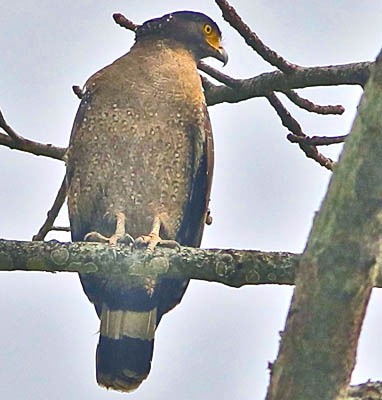 The photo (left) is Crested Serpent-Eagle, a widespread and rather noisy hawk of southern Asia. Representing the snake-eagles is this Beaudouin's Snake-Eagle from the Sahel region of west Africa (below): The photo (left) is Crested Serpent-Eagle, a widespread and rather noisy hawk of southern Asia. Representing the snake-eagles is this Beaudouin's Snake-Eagle from the Sahel region of west Africa (below):
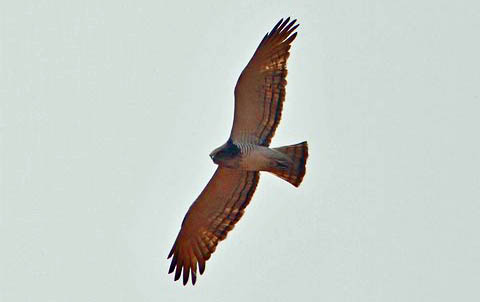
|
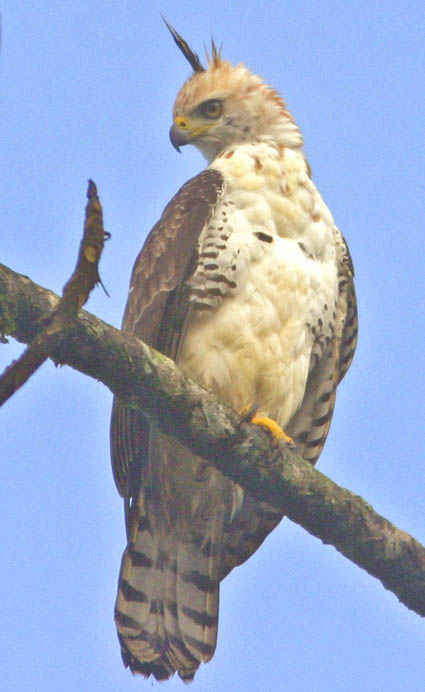 There
are many more hawks in this huge family but I can mention only so many
on this page. So we wrap up with mention of some of the shy,
hard-to-see forest hawks, like those in the genus Leucopternis of the New World tropics (I don't yet have a photo of any of them). I was, however, very happy to photograph these: There
are many more hawks in this huge family but I can mention only so many
on this page. So we wrap up with mention of some of the shy,
hard-to-see forest hawks, like those in the genus Leucopternis of the New World tropics (I don't yet have a photo of any of them). I was, however, very happy to photograph these:
Ornate Hawk-Eagle (right, an immature bird) is widespread throughout the Neotropics but I've only encountered it this one time. White-rumped Hawk (just below) is little-known and mostly overlooked in its South American range.

And the lovely Long-tailed Hawk
(below) is usually overlooked in the thick lowland forests that extend
patchily from west Africa to the Congo Basin. Brown et al. (1982)
called it "uncommon to rare but probably commoner than supposed as very
difficult to observe." It has bright chestnut underparts and very long
tail, and can be found by its vocalizations. It appears to specialize
of squirrels. |
|
| |
Photos: The African Hawk-Eagle Aquila spilogaster was at Tarangire NP, Tanzania, on 9 June 2018. The near-adult Bald Eagle Haliaeetus leucocephalus was in Priest Valley, Monterey Co., CA, USA, on 2 May 2010. The adult Harpy Eagle Harpia harpyja was hunting in the Serra das Araras, Mato Grosso, Brazil, on 4 Aug 1999. Ian Merrill took the wonderful shot of Philippine Eagle Pithecophaga jefferyi on Mt. Katanglad, Mindanao, Philippines, in Feb 2006; my montage with flight shot was taken there in Feb 1990. The young Martial Eagle Polemaetus bellicosus was at Tarangire NP, Tanzania, on 9 June 2018, and the adult was near Brandvlei, South Africa, in July 2005. The young African Fish-Eagle Haliaeetus vocifer
was along the Tarangire River, Tanzania, on 9 June 2018; the adult in
flight was along the Okavango River, Botswana, in July 2005.
The White-backed Vulture Gyps africanus
was in Tarangire NP, Tanzania, on 9 June 2018. As to the three tiers of
vultures at kills, the top tier was west of Agra, India, on 18 Aug
1978, and includes White-rumped Vulture Gyps bengalensis, Indian Vulture Gyps indicus, and even a Steppe Eagle Aquila nipalensis. The next tier was at Corbett NP, India, on 16 Mar 2001, and features Cinereous Vulture Aegypius monachus and Red-headed Vulture Sarcogyps calvus. The bottom vulture set was in Masai Mara NP, Kenya, on 23 Nov 1981, has mostly White-backed Vultures and a couple Lappet-faced Vulture Torgos tracheliotos. The adult with young Lappet-faced Vulture was at Tarangire NP, Tanzania, on 10 June 2018. The Bearded Vulture Gypaetus barbatus was over Heimaihei, Tibetan Plateau, China, on 19 June 2004. The digiscoped Palm-nut Vulture Gypohierax angolensis was at Mole NP, Ghana, on 14 Dec 2013.
The Augur Buzzard Buteo coronatus was at Gibbs Farm, Tarangire, on 10 June 2018. The two photos of nesting Red-tailed Hawk Buteo jamaicensis was near San Lucas, Monterey Co., California, USA, on 2 May 2010. The Grasshopper Buzzard Buteo coronatus was at a fire's edge near Dawadawa, Ghana, on 14 Dec 2013. The Rough-legged Hawk Buteo lagopus was was soaring over Honey Lake, California, USA, in Feb 1981. The Broad-winged Hawk Buteo coronatus diving on the Swainson's Hawk Buteo coronatus was at High Island, Texas, USA, on 25 Apr 2014.
The Spotted Harrier Circaetus assimilis was along the Birdsville Track, South Australia, on 20 Nov 2009. The male Northern Harrier Circaetus hudsonius was at Zmudowski SP, California, USA, on 3 Feb 2016. The trash-dump "Black-eared" Black Kite Milvus migrans lineatus was at Guwahati, Assam, India, on 26 July 2010. The Hook-billed Kite Chondrohierax uncinatus was at Bentsen-Rio Grande SP, Texas, USA, on 26 July 2010. The young Snail Kite Rostrhamus sociabilis was in the Brazilian Pantanal, in Aug 2010. The White-tailed Kite Elanus leucurus was at Pebble Beach, Monterey Co., CA, USA, on 7 Feb 2009. The Letter-winged Kite Elanus scriptus was along the Birdsville Track, South Australia, on 20 Nov 2009. The immature Cooper's Hawk Accipiter cooperi was at Pebble Beach, Monterey Co., CA, USA, on 7 Feb 2009.
The African Harrier-Hawk Polyboroides typus was at Tarangire NP, Tanzania, on 9 June 2018. The Crane Hawk Geranospiza caerulescens was in the Brazilian Pantanal on 20 July 2010. The Crested Serpent-Eagle Spilornis cheela was at Kaziranga NP, Assam, India, on 13 Mar 2019. The Beaudouin's Snake-Eagle Circaetus beaudouini was in northern Ghana, on 14 Dec 2013. The Ornate Hawk-Eagle Spizaetus ornatus was at La Selva, Costa Rica, on 18 Dec 2007. The White-rumped Hawk Parabuteo leucorrhous was at Intervales NP, Brazil, on 30 July 2010. The Long-tailed Hawk Urotriorchis macrourus was at Aboabo, Ghana, on 10 Dec 2013.
All
photos © Don Roberson, except for the Philippine Eagle © Ian
Merrill and used with permission; all rights reserved.
Bibliographic note:
Family book: Rating 
Brown, Leslie, and Dean Amadon. 1968. Eagles, Hawks, and Falcons of the World. 2 vols. McGraw-Hill, New York.
When
this two-volume boxed set came out in the late 1960s, it was the state
of the art on knowledge of the world's raptors. It covered hawks &
eagles, plus falcons and the monotypic families of Osprey and
Secretarybird. The authors were renowned experts on the subject; the
text was reasonably thorough and the range maps up-to-date (for the
time), and every species was pictured on full-page plates showing one
to a half-dozen birds. Sometimes these were six species together; on
other plates it showed age/sex variation, or color morphs, or
subspecies. Eight artists were included, among them legendary names
like Roger Tory Peterson (Old World vultures), Don Eckelberry (large
falcons, including full page paintings of birds like an Indian
Peregrine perched against the backdrop of Rangaswami's Pillow — a
fantastic rock formation — in south India), A. E. Gilbert (great
tropical raptors) and D.M. Henry (his plate of variation in Gyrfalcon
is superb), and Guy Coheleach (a variety of eagles and Buteos). J. C.
Harrison seems to have done most of the lesser-known species... the
"grunt work" as it were (and a good number are printed in
black-and-white. In a book like this, the differences in artistic style
is almost welcomed; these are not "field guide" art to be compared one
to another, but a collection of great artwork combined with an
authoritative text. All that having been said, the classic work is now
showing its age. Much has been learned in the last quarter-century
about ranges; about status; about biology and taxonomy and
identification. Yet in many respects Brown & Amadon's achievement
stands the test of time. It is still a significant primary reference
work on the world's raptors, and their taxonomic comments (especially
at the species level) are still entitled to much deference. One clue to
its value is that few modern works even come close to competing with
it. New efforts, such as Ferguson-Lees & Christie (2001) provide
much updated information, but the new format of such books do not have
the space to publish the evocative art of prior decades.
Literature cited:
Binford, L. C. 1979. Fall migration of diurnal raptors at Pt. Diablo, California. W. Birds 10: 1-16.
Brown, L.H., E.K. Urban, and K. Newman. 1982. The Birds of Africa. Vol. 1. Academic Press, London.
Clark, W. S., and B. K. Wheeler. 1987. A Field Guide to Hawks of North America. Houghton Mifflin, Boston.
Dunne, P., D. Sibley, and C. Sutton. 1988. Hawks in Flight. Houghton Mifflin, Boston.
Ferguson-Lees, J, and D.A. Christie. 2001. Raptors of the World. Houghton Mifflin, Boston.
Forsman, D. 1999. The Raptors of Europe and the Middle East: a Handbook of Field Identification. T. & A.D. Poyser, London.
Heintzelman, D. S. 1976. A Guide to Eastern Hawk Watching. Pennsylvania State Univ., University Park, PA.
Kaufman, K. 1990. A Field Guide to Advanced Birding. Houghton Mifflin, Boston.
Lerner,
H.R., and D.P. Mindell. 2005. Phylogeny of eagles, Old World vultures,
and other Accipitridae based on nuclear and mitochondrial DNA. Molec.
Phylog. Evol. 37: 327-346.
Margalida, A., J. Bertra, and R. Heredia. 2009. Diet and food preferences of the endangered Bearded Vulture Gypaetus barbatus: a basis for their conservation. Ibis. 151: 235–243.
Morris,
P., and F. Hawkins. 1998. Some comments on the identification of six
Madagascar raptors. Bull. African Bird Club 5: 114-119.
Porter,
R. F., I. Willis, S. Christensen, and B. P. Nielsen. Flight
Identification of European Raptors. 3d ed. 1981. P. & A.D. Poyser,
Calton, England.
Schulenberg, T., ed. 2018. Hook-billed Kite (Chondrohierax uncinatus), In
Neotropical Birds Online. Cornell Lab of Ornithology, Ithaca, NY;
retrieved from Neotropical Birds Online:
https://neotropical.birds.cornell.edu/Species-Account/nb/species/hobkit
Thiollay, J. M. 1994. Family Accipitridae (Hawks and Eagles) in
del Hoyo, J., Elliott, A., & Sargatal, J., eds. Handbook of the
Birds of the World. Vol. 2. Lynx Edicions, Barcelona, Spain.
Wheeler, B. K., and W. S. Clark. 1995. A Photographic Guide to North American Raptors. Academic Press, London.
|
|
|

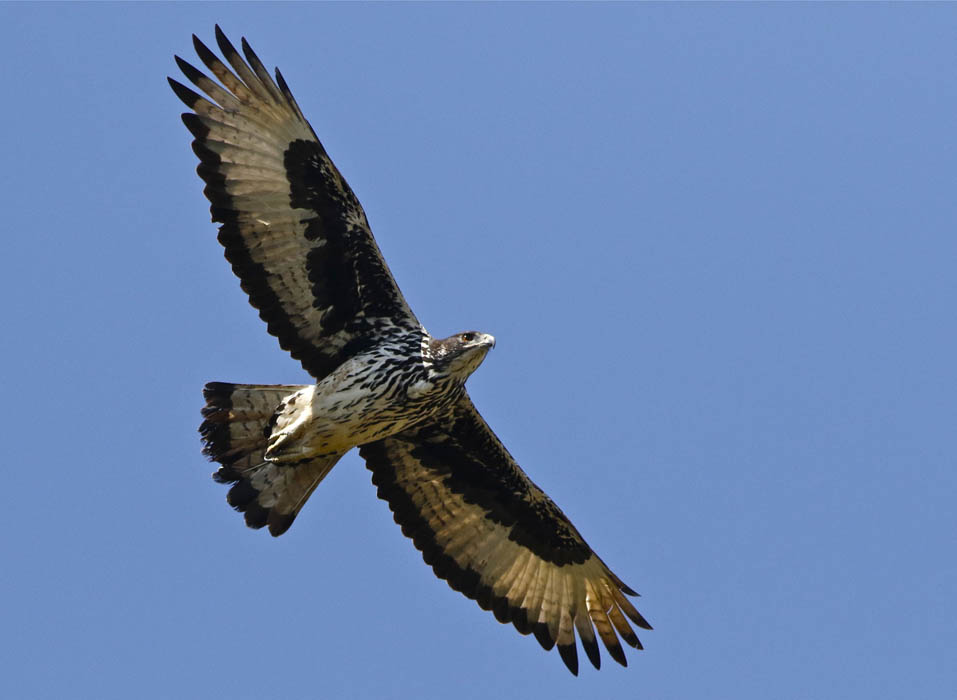
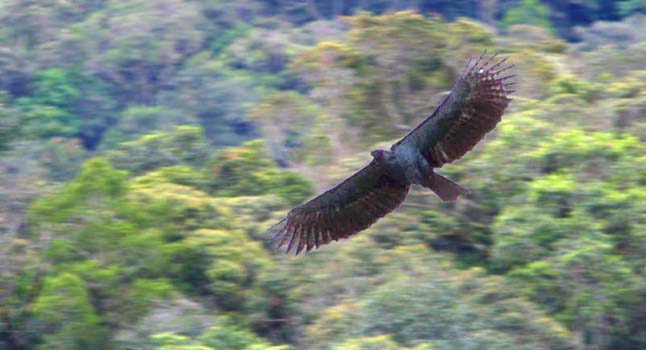
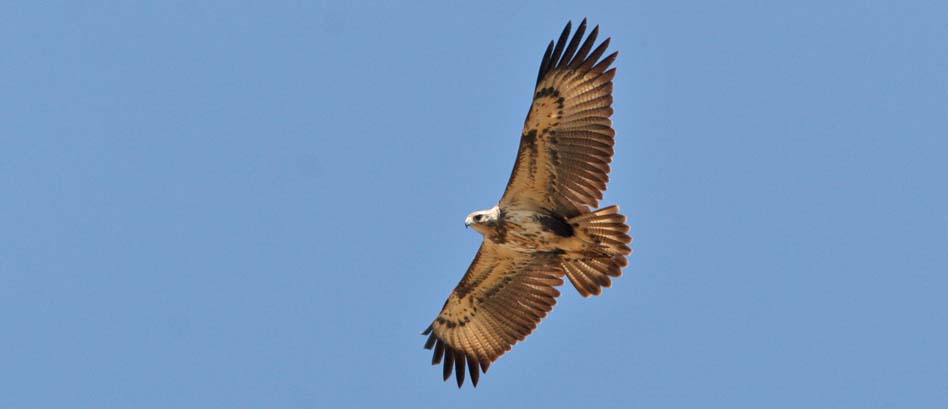

 In
much of the world, and especially the temperate zones, the basic "hawk"
(often called "buzzard" in the Old World) belongs to the genus Buteo or Butastur.
Some 32 species are distributed across the largest continents,
Caribbean islands and Madagascar, and to the Galapagos and Hawaii. In
much of east Africa that species is Augur Buzzard (right). In California where I live our usual hawk — the default i.d. for any large soaring raptor — is the Red-tailed Hawk
(both photos below of the same nest). This nesting pair were raising
two chicks but had to suffer attacks from an aggressive Northern
Mockingbird disturbed by the presence. The mimid's concern seems
unwarranted as Red-tailed Hawk eats small mammals and snakes. As in
many Buteos, the Red-tail comes in a bewildering variety of plumages
and color morphs, the whole spectrum of which cannot be shown in any
literature. One learns to use shape, size and behavior.
In
much of the world, and especially the temperate zones, the basic "hawk"
(often called "buzzard" in the Old World) belongs to the genus Buteo or Butastur.
Some 32 species are distributed across the largest continents,
Caribbean islands and Madagascar, and to the Galapagos and Hawaii. In
much of east Africa that species is Augur Buzzard (right). In California where I live our usual hawk — the default i.d. for any large soaring raptor — is the Red-tailed Hawk
(both photos below of the same nest). This nesting pair were raising
two chicks but had to suffer attacks from an aggressive Northern
Mockingbird disturbed by the presence. The mimid's concern seems
unwarranted as Red-tailed Hawk eats small mammals and snakes. As in
many Buteos, the Red-tail comes in a bewildering variety of plumages
and color morphs, the whole spectrum of which cannot be shown in any
literature. One learns to use shape, size and behavior. 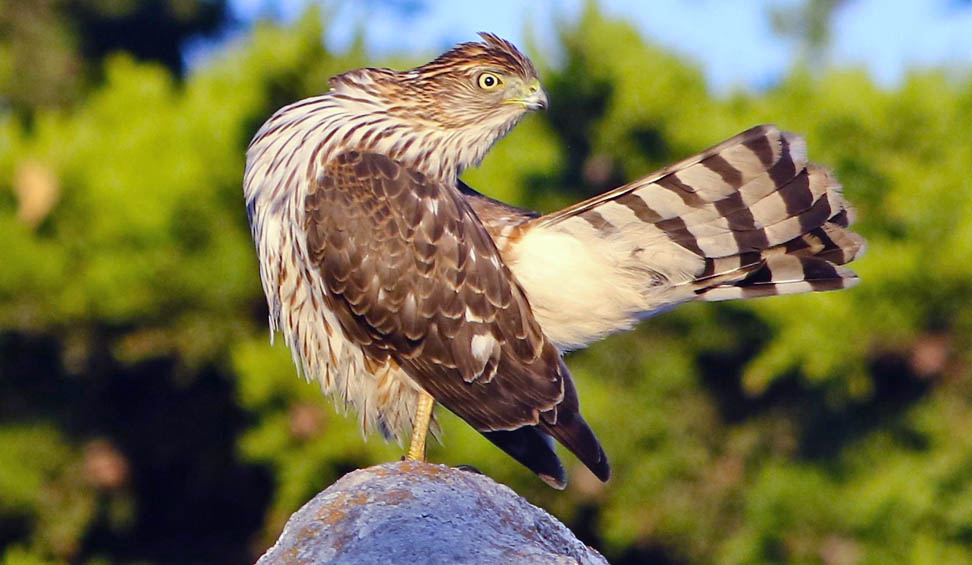

 A
set of very opportunistic hawks are the harrier-hawks of Africa and
Madagascar (two species; sometimes called Gymnogenes) and the Crane
Hawk of the Neotropics. Both the African Harrier-Hawk (near right) and the Crane Hawk
(far right) are mid-sized, lanky, long-legged raptors of open forests
that sport a short crest. The Harrier-Hawk is also bare-faced. Over the
years various authors have noted similarities in morphology and feeding
habitats between these widely separated species. Both prey upon small
mammals, frogs, lizards, bird nests, and insects, which are found by
climbing around on tree trunks and limbs, peering into crevices and
holes while hanging at odd angles. The Harrier-Hawk even has a
reversible intertarsal ("knee") joint which can bend backward, as well
as forward, enabling the bird to reach into deep holes to extract the
contents. For prey that would otherwise be inaccessible, they may hang
under branches, keeping balance with flapping wings, and grabbing
anything that they find. Hunting techniques include raids on colonies
of nesting weavers or oropendolas, taking eggs and nestlings.
Harrier-Hawk also eats oil palm fruit, fish, and carrion. Despite
multiple similarities, these are examples of convergent evolution and
are not closely related (Lerner & Mindell 2005).
A
set of very opportunistic hawks are the harrier-hawks of Africa and
Madagascar (two species; sometimes called Gymnogenes) and the Crane
Hawk of the Neotropics. Both the African Harrier-Hawk (near right) and the Crane Hawk
(far right) are mid-sized, lanky, long-legged raptors of open forests
that sport a short crest. The Harrier-Hawk is also bare-faced. Over the
years various authors have noted similarities in morphology and feeding
habitats between these widely separated species. Both prey upon small
mammals, frogs, lizards, bird nests, and insects, which are found by
climbing around on tree trunks and limbs, peering into crevices and
holes while hanging at odd angles. The Harrier-Hawk even has a
reversible intertarsal ("knee") joint which can bend backward, as well
as forward, enabling the bird to reach into deep holes to extract the
contents. For prey that would otherwise be inaccessible, they may hang
under branches, keeping balance with flapping wings, and grabbing
anything that they find. Hunting techniques include raids on colonies
of nesting weavers or oropendolas, taking eggs and nestlings.
Harrier-Hawk also eats oil palm fruit, fish, and carrion. Despite
multiple similarities, these are examples of convergent evolution and
are not closely related (Lerner & Mindell 2005). 
 The
Accipitridae — the family of hawks, eagles, kites, harriers, and Old
World vultures — includes some of the world's most awe-inspiring birds.
The sizes of birds-of-prey range from the tiny Pearl Kite Gampsonyx swainsonii
of South America, at a maximum of 100 grams, to the largest Old World
vultures at up to 12.5 kg, some 12-and-half times larger (Thiollay
1994). There are large and impressive eagles on every wooded continent.
Two examples are African Hawk-Eagle of sub-Saharan Africa (above) and Bald Eagle
of North America (left). Among the most spectacular are those great
tropical eagles that subsist on arboreal mammals. In Africa,
Verraeaux's Eagle Aquila verreauxii makes a specialized living on hyraxes. The BBC series "The Life of Birds with David Attenborough" has incredible shots of Martial Eagles hunting monkeys. In the Neotropics there is Harpy Eagle
(below left); we'd unintentionally flushed this adult from its prey (a
forest deer) not far from a known nest. And in the Philippines, the
greatest of all eagles — the Great Philippine Eagle,
once called the "Monkey-eating Eagle" (below right in an outstanding
shot by Ian Merrill) — hunts the treetops for civets, colugos, flying
squirrels, and monitor lizards.
The
Accipitridae — the family of hawks, eagles, kites, harriers, and Old
World vultures — includes some of the world's most awe-inspiring birds.
The sizes of birds-of-prey range from the tiny Pearl Kite Gampsonyx swainsonii
of South America, at a maximum of 100 grams, to the largest Old World
vultures at up to 12.5 kg, some 12-and-half times larger (Thiollay
1994). There are large and impressive eagles on every wooded continent.
Two examples are African Hawk-Eagle of sub-Saharan Africa (above) and Bald Eagle
of North America (left). Among the most spectacular are those great
tropical eagles that subsist on arboreal mammals. In Africa,
Verraeaux's Eagle Aquila verreauxii makes a specialized living on hyraxes. The BBC series "The Life of Birds with David Attenborough" has incredible shots of Martial Eagles hunting monkeys. In the Neotropics there is Harpy Eagle
(below left); we'd unintentionally flushed this adult from its prey (a
forest deer) not far from a known nest. And in the Philippines, the
greatest of all eagles — the Great Philippine Eagle,
once called the "Monkey-eating Eagle" (below right in an outstanding
shot by Ian Merrill) — hunts the treetops for civets, colugos, flying
squirrels, and monitor lizards. 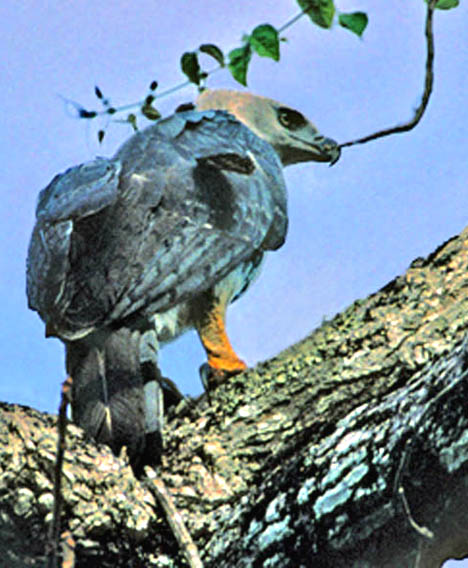
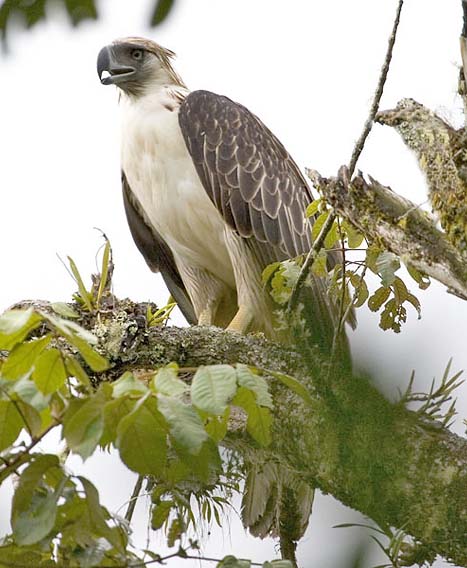
 I've
had the good fortune to have quality experiences with both a nesting
Harpy Eagle and a nesting Philippine Eagle. The story of seeing the
latter at its nest in the wild in February 1990, with more photos,
I've
had the good fortune to have quality experiences with both a nesting
Harpy Eagle and a nesting Philippine Eagle. The story of seeing the
latter at its nest in the wild in February 1990, with more photos, 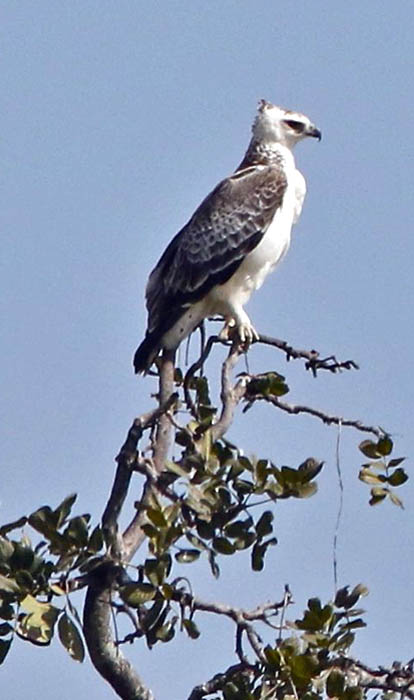

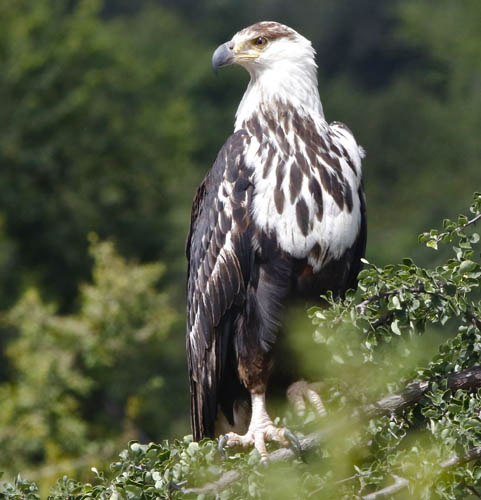
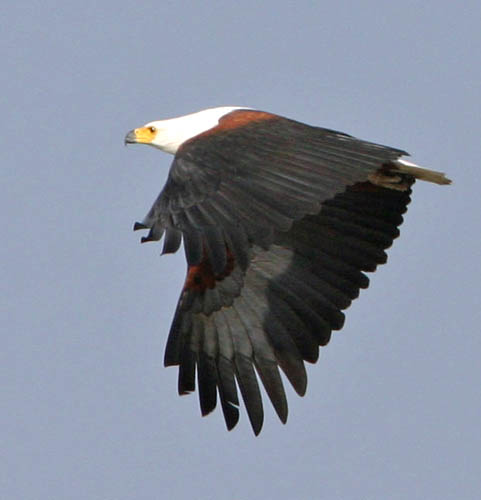
 There are huge eagles at high latitudes also. In far northeastern Asia, a large female Steller's Sea-Eagle
may be the world's heaviest eagle. These impressive giants winter south
to Japan. Our only encounter, though, was this vagrant in North
America: an adult that spent a couple of years near Juneau, Alaska. To
see it one had to charter a helicopter to fly over the glaciers in the
mountains behind town, and follow the Taku River, trying to spot it as
it sat atop a riverside conifer (below).
There are huge eagles at high latitudes also. In far northeastern Asia, a large female Steller's Sea-Eagle
may be the world's heaviest eagle. These impressive giants winter south
to Japan. Our only encounter, though, was this vagrant in North
America: an adult that spent a couple of years near Juneau, Alaska. To
see it one had to charter a helicopter to fly over the glaciers in the
mountains behind town, and follow the Taku River, trying to spot it as
it sat atop a riverside conifer (below).
 Another
impressive group is the Old World Vultures [New World vultures are only
distantly related to hawks, and are placed in their own Family.] Times
are changing for many Old World vultures. Several, such as White-backed Vulture
(right) and of sub-Saharan Africa (right), have joined the list of
critically endangered vultures that began with the large vultures of
India since 2000. The White-rumped Vulture of south
Asia (there are more than 50 gathered at the carcass shown below) was
estimated at several million in the 1980s. As of 2016, the global
population was estimated at less than 10,000 adults. These and other
Asian vultures have crashed due to renal failure caused by diclofenac
poisoning. Until banned recently, diclofenac was used in veterinary
care of the abundant cattle in south Asia. It wiped out 99% of the
world's population of White-rumped Vulture, Slender-billed Vulture Gyps tenuirostris, and Indian Vulture G. indicus,
as well as many Red-headed Vulture Sarcogyps calvus. In recent years,
the use of diclofenac, as well as the use of strychnine and other
poisons, in Africa has led to very serious declines in White-backed
Vulture, Rüppell's Vulture Gyps rueppelli, and
Lappet-faced Vulture. In Africa, cattle grazing has taken over much
formerly wild land in which African vultures would consume the
carcasses of kills from lions, leopards, and hyenas.The three photos
below illustrate vulture abundance in earlier times. One cannot now see
a gathering White-rumped Vultures in India as show in my 1978 shot:
Another
impressive group is the Old World Vultures [New World vultures are only
distantly related to hawks, and are placed in their own Family.] Times
are changing for many Old World vultures. Several, such as White-backed Vulture
(right) and of sub-Saharan Africa (right), have joined the list of
critically endangered vultures that began with the large vultures of
India since 2000. The White-rumped Vulture of south
Asia (there are more than 50 gathered at the carcass shown below) was
estimated at several million in the 1980s. As of 2016, the global
population was estimated at less than 10,000 adults. These and other
Asian vultures have crashed due to renal failure caused by diclofenac
poisoning. Until banned recently, diclofenac was used in veterinary
care of the abundant cattle in south Asia. It wiped out 99% of the
world's population of White-rumped Vulture, Slender-billed Vulture Gyps tenuirostris, and Indian Vulture G. indicus,
as well as many Red-headed Vulture Sarcogyps calvus. In recent years,
the use of diclofenac, as well as the use of strychnine and other
poisons, in Africa has led to very serious declines in White-backed
Vulture, Rüppell's Vulture Gyps rueppelli, and
Lappet-faced Vulture. In Africa, cattle grazing has taken over much
formerly wild land in which African vultures would consume the
carcasses of kills from lions, leopards, and hyenas.The three photos
below illustrate vulture abundance in earlier times. One cannot now see
a gathering White-rumped Vultures in India as show in my 1978 shot: 


 Today, congregations of African vultures are often limited to National Parks and preserves. This shot of a young Lappet-faced Vulture with its parent was at a nest in Tarangire NP, Tanzania.
Today, congregations of African vultures are often limited to National Parks and preserves. This shot of a young Lappet-faced Vulture with its parent was at a nest in Tarangire NP, Tanzania. 
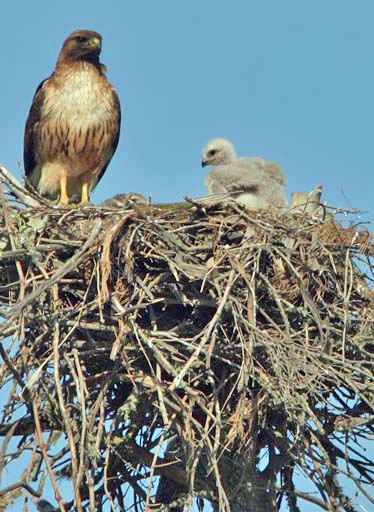
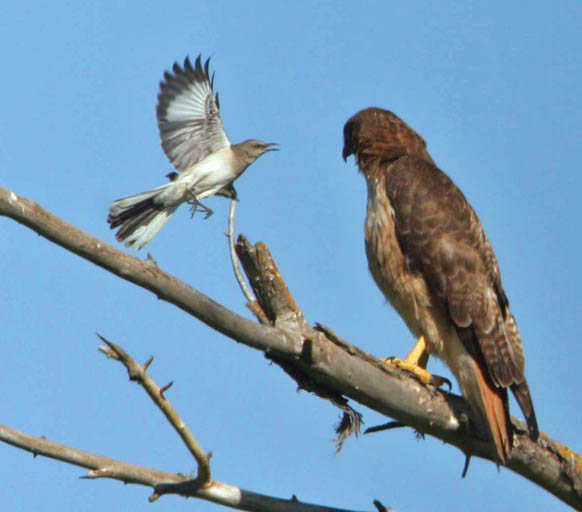

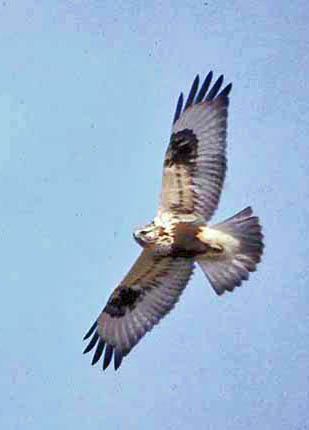
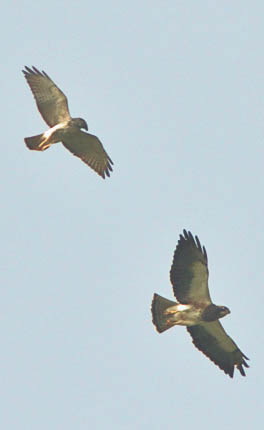
 There are 16 species of harriers in genus Circus scattered throughout the world. Most hunt small mammals by quartering over marshes and wetlands on tilt-up wings. Spotted Harrier (right) of Australia can survive in the vast arid desert in the interior of the continent.
There are 16 species of harriers in genus Circus scattered throughout the world. Most hunt small mammals by quartering over marshes and wetlands on tilt-up wings. Spotted Harrier (right) of Australia can survive in the vast arid desert in the interior of the continent.
 There
are almost 30 raptors in 18 genera that are called "kites." This is not
a natural groups but, rather, an assortment of mid-sized hawks, some of
which excel at 'kiting" — effortlessly soaring and gliding in thermals
in search of food —or gracefully "hanging in the air" by hovering.
Black Kites (Milvus migrans) and is widespread across
Eurasia and Africa, various considered either three species (Black
Kite, Yellow-billed Kite, Black-eared Kite) or one polymorphic and
variable species. Some populations are resident and otherwise
migratory. Many populations live commensally with humans, becoming a
very familiar species and heir angled wing and forked tail makes them
easy to identify. Global population estimates run up to 6 million
individuals. Unlike other kites, Black Kites are opportunistic hunters
and are more likely to scavenge. This "Black-eared" Blake Kite (left) is scavenging in a huge rubbish dump in eastern India.
There
are almost 30 raptors in 18 genera that are called "kites." This is not
a natural groups but, rather, an assortment of mid-sized hawks, some of
which excel at 'kiting" — effortlessly soaring and gliding in thermals
in search of food —or gracefully "hanging in the air" by hovering.
Black Kites (Milvus migrans) and is widespread across
Eurasia and Africa, various considered either three species (Black
Kite, Yellow-billed Kite, Black-eared Kite) or one polymorphic and
variable species. Some populations are resident and otherwise
migratory. Many populations live commensally with humans, becoming a
very familiar species and heir angled wing and forked tail makes them
easy to identify. Global population estimates run up to 6 million
individuals. Unlike other kites, Black Kites are opportunistic hunters
and are more likely to scavenge. This "Black-eared" Blake Kite (left) is scavenging in a huge rubbish dump in eastern India. 

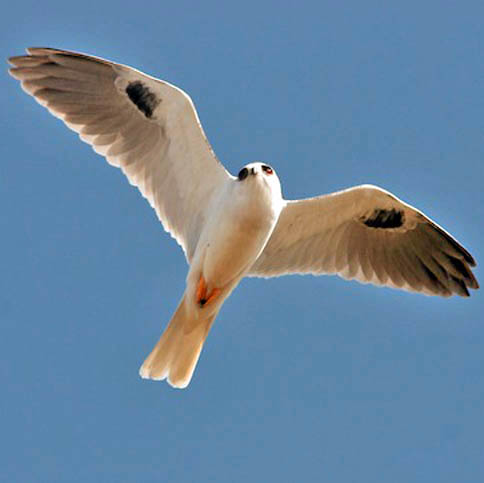
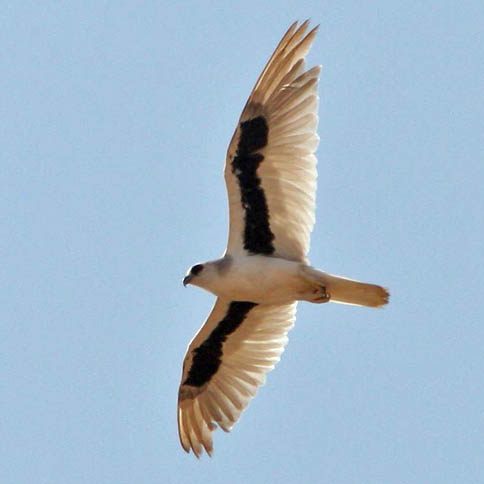
 The photo (left) is Crested Serpent-Eagle, a widespread and rather noisy hawk of southern Asia. Representing the snake-eagles is this Beaudouin's Snake-Eagle from the Sahel region of west Africa (below):
The photo (left) is Crested Serpent-Eagle, a widespread and rather noisy hawk of southern Asia. Representing the snake-eagles is this Beaudouin's Snake-Eagle from the Sahel region of west Africa (below): 
 There
are many more hawks in this huge family but I can mention only so many
on this page. So we wrap up with mention of some of the shy,
hard-to-see forest hawks, like those in the genus Leucopternis of the New World tropics (I don't yet have a photo of any of them). I was, however, very happy to photograph these:
There
are many more hawks in this huge family but I can mention only so many
on this page. So we wrap up with mention of some of the shy,
hard-to-see forest hawks, like those in the genus Leucopternis of the New World tropics (I don't yet have a photo of any of them). I was, however, very happy to photograph these:
